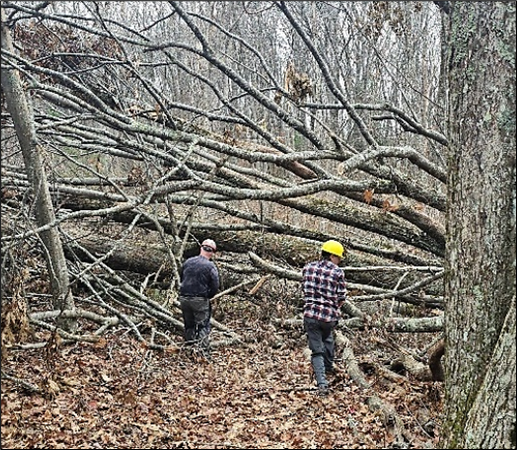Current Status:
Closure notice for the Appalachian Trail (link to Forest Order# 08-11-08-25-01) designated within the Appalachian Ranger District (ARD) of the Pisgah National Forest (PNF, North Carolina) continues (last updated 3/14/2025) to remain officially closed from Indian Grave to to Hughes Gap (AT NOBO mileage 352.9 to 374.2). However, a detour (link) has been established around Iron Mountain Gap (NOBO mileage 360.6 to 365.9) which is marked with temporary plastic white blazes and maps at each end. The bypassed section is blocked with excessive downed timber slated for removal this summer, thus hikers are not to be in this closed areas due to its hazards.
A new PNF/ARD Forest Order No. 08-11-08-25-02 (not yet publically posted at the time this update was written) prohibits campfires within the Roan Mountain area (Hughes Gap to Doll Flats). Camp stoves are allowed if the area is barren or cleared of all overhead and surrounding flammable materials within three feet. It is effective until 9/8/2025 unless lifted earlier. Enforcement will begin with a fire prevention tech talking to folks up in this high use spots within the closure area. Everyone should emphasize that campfires are not be used through any Helene damaged areas.
New: A no-charge ferry service has been established by the Appalachian Trail Conservancy (ATC) for hikers across the Nolichucky River at the Chestoa Pike bridge which was washed away by Hurricane Helene. (Link) It will operate between 9am to 2pm from March 17th to June 15th, unless inclement weather conditions pause the service. Hikers are required to sign a release form, wear a life jacket, and follow instructions. Alternative is an official 3.6 mile road walk detour. Please be careful as the roads are not hiker-friendly, missing sidewalks with vehicle traffic on some sections. The plan to replace the bridge has been announced, thus is in the early design phase.
The Moreland Gap Shelter is open. The metal roof has been covered with a heavy tarp, but could leak in a heavy rain. Long-term plans will be discussed for the shelter
Continuing Efforts:
While the A.T. is “Open”, it does not mean it is completely safe or cleared to all locations. Dead trees will continue fall. Please watch out for hazard trees at bridges, shelters, campsites, and water sources; reporting any to the club and/or forest service to give priority for removal. The focus is transitioning from punching through the primary path to the subsequent priorities of removing blowdowns from key campsites, around shelters, and on blue blaze trails to water. The club will also be repairing the deep holes in the tread caused by the many root balls pulled out of the ground.
The Southern Appalachian Wilderness Stewards (SAWS) have provided a path through the Pond Mountain Wilderness (between Dennis Cove Road and US321) and Big Laurel Branch Wilderness (containing Vandeventer shelter).
While the trail club continues regular weekly crews with some weekend trips, the weather forecast will impact the actual workdays and locations. Bad weather has delayed twice a joint effort with the Elizabethton High School Mountain Club. At the meeting location (frequently the Roan Mountain Community Park), volunteers will be divided into small groups for the assignments. Third Saturday trail maintenance is also being done at Bays Mountain Park in Kingsport.






